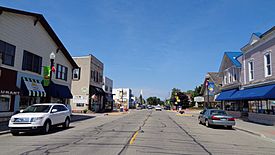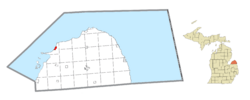Caseville, Michigan facts for kids
Quick facts for kids
Caseville, Michigan
|
|
|---|---|

Looking north along M-25
|
|

Location within Huron County
|
|
| Country | United States |
| State | Michigan |
| County | Huron |
| Settled | 1836 |
| Incorporated | 1896 (village) 2010 (city) |
| Area | |
| • Total | 1.15 sq mi (2.97 km2) |
| • Land | 1.12 sq mi (2.90 km2) |
| • Water | 0.03 sq mi (0.08 km2) |
| Elevation | 600 ft (183 m) |
| Population
(2020)
|
|
| • Total | 652 |
| • Density | 582.66/sq mi (225.02/km2) |
| Time zone | UTC-5 (Eastern (EST)) |
| • Summer (DST) | UTC-4 (EDT) |
| ZIP code(s) |
48725
|
| Area code(s) | 989 |
| FIPS code | 26-13760 |
| GNIS feature ID | 0622835 |
Caseville is a small city in Huron County, Michigan. It sits right where the Pigeon River flows into Saginaw Bay, which is part of Lake Huron. In 2020, about 652 people lived there.
Caseville is a popular spot for summer visitors. It's famous for its 10-day Cheeseburger in Caseville festival. This fun event celebrates Jimmy Buffett's song "Cheeseburger in Paradise." People also call Caseville the "Perch Capital of Michigan" because of the many yellow perch fish caught there.
Contents
Caseville's Story: A Look Back in Time
Caseville was first settled by people from Europe in 1836. The first settler was Reuben Dodge. They called the area Pigeon River Settlement because it was at the mouth of the Pigeon River.
Later, it was known as Port Elizabeth or Elizabethtown. These names honored the wife of William Rattle. He worked for a big landowner named Leonard Case. The town grew because of the lumber industry. Timber was sent by lake to different markets. Building ships and making salt were also important early jobs.
In 1856, Francis Crawford bought a lot of land around the community. That same year, the town officially became known as Caseville. A post office opened there in 1863, with Crawford as the postmaster. In 1896, Caseville became an official village.
The Cheeseburger in Caseville festival started in 1999. It was a three-day event at first. By 2004, it had become a huge 10-day festival. In 2010, Caseville changed from a village to a city.
Where is Caseville? Geography Facts
Caseville is located in a part of Michigan known as "the Thumb." This area is shaped like a thumb on a map. It's part of the wider Flint/Tri-Cities region.
The city has a total area of about 1.13 square miles (2.9 square kilometers). Most of this is land, with a small amount of water. Caseville grew along the Pigeon River. This helped create a harbor for shipping goods through Saginaw Bay and the Great Lakes.
Who Lives in Caseville? Population Details
| Historical population | |||
|---|---|---|---|
| Census | Pop. | %± | |
| 1880 | 634 | — | |
| 1890 | 508 | −19.9% | |
| 1900 | 507 | −0.2% | |
| 1910 | 442 | −12.8% | |
| 1920 | 385 | −12.9% | |
| 1930 | 412 | 7.0% | |
| 1940 | 451 | 9.5% | |
| 1950 | 482 | 6.9% | |
| 1960 | 659 | 36.7% | |
| 1970 | 607 | −7.9% | |
| 1980 | 851 | 40.2% | |
| 1990 | 857 | 0.7% | |
| 2000 | 888 | 3.6% | |
| 2010 | 777 | −12.5% | |
| 2020 | 652 | −16.1% | |
| U.S. Decennial Census | |||
In 2010, there were 777 people living in Caseville. There were 422 households, which are groups of people living together. About 221 of these were families. The average household had 1.84 people, and the average family had 2.46 people.
Most people in Caseville were White (97.8%). About 0.9% of the population was Hispanic or Latino. The average age in Caseville was 55.1 years old. About 11.3% of residents were under 18. Also, 28.4% were 65 years or older.
Fun Things to Do in Caseville
The yearly Cheeseburger in Caseville festival is a big event. It happens at the end of summer and includes concerts and activities for families. Many summer cottages and houses are available to rent in the area. These are great for vacations.
Nearby, you can visit Sleeper State Park. It has campgrounds and many trails to explore different natural areas. Port Crescent State Park is also close by.
See also
 In Spanish: Caseville para niños
In Spanish: Caseville para niños


